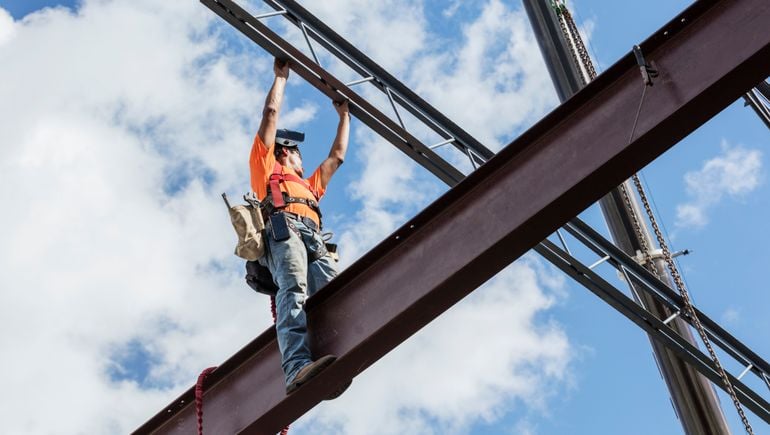Three construction workers in Charlotte, North Carolina, died in a scaffolding collapse on Jan. 2, thrusting construction safety into the national spotlight at the beginning of the new year.
The three deceased were identified as Jose Canaca, Gilberto Monico Fernandez and Jesus “Chuy” Olivares Charlotte Observer reported. Two others were injured in the collapse. The Charlotte Mecklenburg Police Department and the state’s safety and health division are investigating.
The Bureau of Labor Statistics reported 52 deaths in 2020 specifically due to falls from scaffolding.
Several OSHA regulations address proper procedures for erecting and using scaffolding at construction sites. They lay out guidance on topics including scaffolding load weights, planking, walkway widths, counterweights, restraints and supports. For example, employers must provide fall protection for all employees who use scaffolding that’s more than 10 feet above another level. Fall protection includes guardrail systems and personal fall-arrest systems such as harnesses and lifelines.
OSHA also requires all employees who erect or use scaffolding to be trained by a qualified person about that specific scaffolding’s hazards and how to minimize incident risk.
Nevertheless, safety rules and regulations are not always followed, something that puzzles Richard Fairfax, principal consultant for the National Safety Council.
“Regulations have been in place for a while, and frankly I don’t see any reason why they wouldn’t be followed,” Fairfax said. When accidents occur, often “people make a decision not to follow [OSHA regulations]or they take a shortcut and decide they’re not going to do a certain step if they’re trying to get the job done.”
A plethora of safety enhancement and risk-reduction resources are available to employers, Fairfax said, such as OSHA’s free compliance assistance service. NSC also provides safety at heights resourcesincluding a guide to technology solutions — like robotics, drones and sensors — that reduce the risk of falls.
Drones navigate to heights or hard-to-reach places for quicker, safer monitoring of the highest points of the jobsite, rather than sending a worker up several stories. Wearables monitor workers who are isolated, and, should they sustain an injury or trauma, immediately notify someone else.
Taking responsibility
A recent survey from The Center for Construction Research and Training (CPWR) focused on identifying leading causes of falls from heights. Respondents point to poor planning (27.4%) as a primary cause, which results in a lower likelihood of protective equipment use.
Ongoing employer engagement and worker safety training correlates to higher levels of safe practices on-site. Study respondents who believed employers require the use of fall protection were eight times more likely to use it compared with those who didn’t believe fall protection was an employer requirement.
“A lot of people think the burden of safety under OSHA falls to the employees — and certainly employees have a responsibility to wear personal protective equipment, follow the requirements and things like that — but safety and health on a worksite is really the employer’s responsibility,” Fairfax said.
However, responsibilities can “get confusing” because of all the parties involved in a construction project, he said.
“You’ve got the owner of the site, the prime contractor, then you have a lot of subcontractors,” Fairfax said. “OSHA has put into place what’s called a multi-employer policy to hold any employer that has some responsibility [accountable] … to ensure that employees are protected.”
New York’s Scaffold Law
Despite OSHA’s multi-employer stance, one state has taken a stand on where the fault lies when a scaffolding accident occurs. New York labor laws contain the so-called “Scaffold Law” that places absolute liability for on-site, “gravity-related” safety on property owners and general contractors. Opponents say the antiquated regulation is a misnomer and has nothing to do with scaffold safety, only incident liability. Proponents, such as the New York Committee for Occupational Health and Safetysay the law protects workers, and that employers only are liable when an injury or fatality occurs.
The regulation makes construction in New York much more expensive and projects are more difficult to insure, said Mike Elmendorf, president and CEO of the Associated General Contractors of New York State.
“It’s a 100-year-old law that was put on the books before you had OSHA, before you had workers’ compensation, before you had various appropriate worker protections,” he said. “It really is a very unfair law, and that’s probably the reason why New York is the only state that has it.”
In 1995, Illinois repealed a similar decades-old scaffold law, the last remaining besides New York’s. Elmendorf recommends similar action, or at least an amendment, in New York.
Rather than believing a scaffold law improves safety, he recommends taking advantage of training sessions on OSHA regulations for scaffolding safety.








